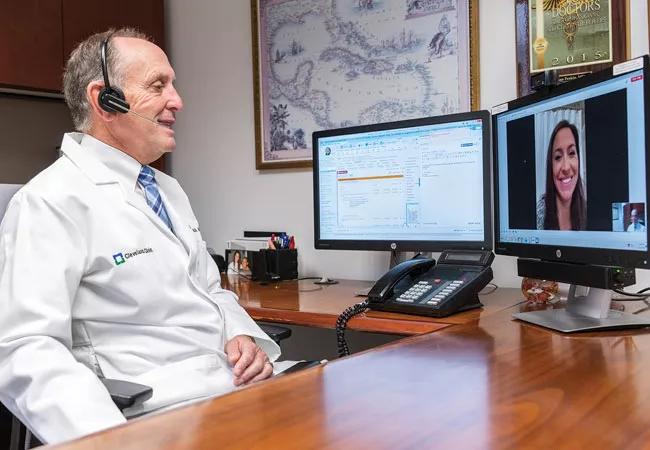Even high-risk pregnancies can be managed without sacrificing quality of care

Julian Peskin, MD, MBA is one of a handful of Ob/Gyns in Cleveland Clinic’s Ob/Gyn & Women’s Health Institute (WHI) who have embraced virtual visits for several years. Although he was unapologetic fan of telemedicine for the many benefits he explained in a previous Consult QD article, most of his colleagues hesitated to embrace the technology.
Cleveland Clinic is a non-profit academic medical center. Advertising on our site helps support our mission. We do not endorse non-Cleveland Clinic products or services. Policy
Then came COVID-19.
“We went from 2% of patients being seen virtually to 80%,” he says. “Skeptics were quickly reassured that the quality of care is the same as that of an in-person visit, and their patients love it.”
Dr. Peskin’s initial foray into telemedicine started by inviting low-risk obstetrical patients to have several prenatal visits — generally at weeks 22, 26 and 32 — done virtually. Patient response was excellent, and he felt the level of care he provided was undiminished. Yet he was reluctant to expand the use of telemedicine to other types of patients.
After COVID-19 forced the staff to provide virtual care for patients for a variety of reasons, it became apparent that infertility consults, preconception counseling, discussions about birth control, preoperative counseling, post-laparoscopic surgery and other issues could be handled successfully through virtual visits.
“There is no reason to come into the office to talk about a simple issue such as minor bleeding, the need to switch contraception medications or what a surgical procedure will entail,” he says.
The caveat is that a video link is indispensible. The physicians felt that virtual visits conducted over by phone alone were inadequate.
“You need face-to-face eye contact,” he says. “It doesn’t have to be in the office, but you need to see the patient’s expression and pick up on nonverbal cues. When you have this ability, the virtual visit experience is Identical to that of an in-person visit.”
Success with virtual visits has prompted the WHI staff to revise certain protocols. One of these is the two-week postpartum checkup. Cleveland Clinic obstetricians now conduct this visit virtually, primarily to screen the mother for postpartum depression.
“To make a new mother come all the way here to ask her 10 depression screening questions is inappropriate,” says Dr. Peskin.
“We also ask how breastfeeding is going, inquire about any bleeding she may have and how her laceration is healing, but that’s it. The entire visit takes 10 minutes. Virtual visits are ideal for this use.”
In addition to the convenience telemedicine offers to low-risk patients, it didn’t take Dr. Peskin long to realize that high-risk patients may derive even greater benefit from virtual visits. These are often the patients for whom the stress of an office visit poses a significant threat to their health or the health of their unborn child: For example, patients at risk for premature labor confined to bed rest.
“We were asking them to come into the office twice a week. COVID-19 showed us they could easily be monitored at home, as could patients at risk for premature delivery, those with premature cervical dilation, slowly rising blood pressure and diabetes,” he says.
Although virtual visits can be conducted from the office, Dr. Peskin found it them difficult to work into a busy clinic day. The solution was to spend one day a week doing virtual visits from home.
“It does not feel as rushed. We are not worried about running late or how many patients are waiting to see us,” he says. “We are able to concentrate on our patient and, because virtual visits seem to be more focused, we also have time for charting.”
Seeing patients from home allows a provider to work nontraditional hours without incurring additional overhead. Dr. Peskin’s virtual office opens at 6:30 am to accommodate young mothers whose children are still asleep.
“If you start early or stay late, you don’t have to have a medical assistant on hand or someone at the front desk doing check in,” he says.
Seeing patients virtually also reduces the number of patients in the waiting room, which makes it easier to manage social distancing.
Cleveland Clinic began easing restrictions on outpatient visits in late May. As expected, the percentage of virtual visits has started to drop.
“Providers who didn’t want to do virtual visits in the first place will revert to in-person visits, but there are also many doubters who are now active telemedicine participants,” says Dr. Peskin. “Seeing 2% of patients virtually is too few, and 80% is too many. I expect we will settle on 15% to 20%, depending on the service line, and that should be just right.”

How we create obstacles for sexual, reproductive and menopausal healthcare despite our best intentions

One approved non-hormonal therapy and another on the horizon reduce vasomotor symptoms

Some post-menopausal patients may benefit from treatment

Study shows higher rates of complications, laparotomies among non-white women

Proper diagnosis and treatment require a careful mix of patient and clinical considerations

Study uniquely powered to compare adverse effects

What is female hypoactive sexual desire disorder and how is it treated?

Indications and best-practice recommendations for the use of androgen therapy